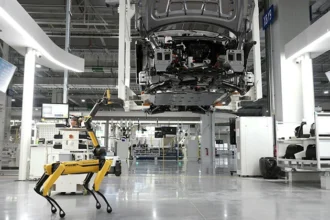In the complex realm of electrical distribution systems, the pivotal role played by switchgear cannot be overstated. As a critical component, switchgear ensures the seamless flow and control of electrical power, safeguarding equipment and optimizing operational efficiency. In this comprehensive exploration, we will delve into the intricacies of switchgear, its types, functionalities, and the indispensable role it plays in maintaining a reliable and secure electrical infrastructure.
Understanding the Essence of Switchgear
Switchgears refer to combination of electrical switches, fuses and circuit breakers for controlling, protecting, and isolating electrical equipment. Essentially, switchgear acts as the central nervous system of an electrical network, enabling safe as well as efficient distribution of power in a facility or across an entire grid.
Components of Switchgear
Switchgear is a complex system comprised of various components, each serving a specific function in the control, protection, and electrical power distribution. Understanding the key components of switchgear is crucial for ensuring safe and efficient operations of electrical systems. Here are the essential components of switchgear:
- Circuit Breakers: Circuit breakers are perhaps the most critical components of switchgear. These components are designed to interrupt flow of electrical current in the event of a fault or overload. Circuit breakers play a vital role in protecting electrical equipment and preventing damage to the system.
- Switches: Switches in switchgears are used in controlling flow of electricity. They can be manually operated or automatically controlled, allowing for the connection or disconnection of electrical circuits. Switches are fundamental for isolating equipment during maintenance or in event of a fault.
- Fuses: Fuses serve as overcurrent protection devices in switchgear. The components are designed to melt or blow when the currents exceed a specified level, thereby interrupting the circuit and preventing damage. Fuses are crucial for safeguarding equipment from overloads and short circuits.
- Relays: These are electromechanical or solid-state devices that play a role in the automation and protection functions of switchgear. They monitor electrical parameters such as current, voltage, and frequency and actuate switches or circuit breakers in response to specific conditions.
- Busbars: Busbars are conductive bars or strips that serve as a common connection point for multiple circuits in switchgear. They provide a pathway for flow of the electrical current between different components, ensuring a reliable as well as efficient distribution of power.
- Isolators (Disconnectors): Isolators, also known as disconnectors, are used for the isolation of specific sections of an electrical system. Unlike circuit breakers, isolators do not provide protection against faults. Instead, their primary function is to physically disconnect equipment for maintenance purposes.
- Earthing (Grounding) System: The earthing system is a crucial safety component in switchgear. It ensures that in an event of a fault, excess electrical current is safely directed into the ground, preventing the risk of electric shock and minimizing damage to equipment.
- Control Panel: The control panel houses the various control and monitoring devices in switchgear. It includes switches, indicators, meters, and other instruments that allow operators to monitor the status of electrical systems and control its operation.
- Protection Relays: Protection relays are specialized relays designed to detect abnormal conditions in the electrical system, such as overcurrent, under-voltage, or phase imbalances. When fault is detected, protection relays initiate protective actions, such as tripping circuit breakers, to prevent further damage.
- Meters and Instrumentation: Meters and instrumentation in switchgear provide real-time information about the electrical parameters of the system. This includes voltage, current, power factor, and other relevant data, enabling operators to monitor and manage the performance of the electrical network.
- Arc Quenching Devices: In high-voltage switchgear, arc quenching devices are employed to extinguish or minimize the effects of electrical arcs that may occur during the interruption of a circuit. These devices enhance the safety of switchgear by rapidly extinguishing arcs to prevent damage.
- Enclosures: Enclosures house and protect the various components of switchgear from environmental factors and unauthorized access. The type of enclosure used depends on the specific application and environmental conditions.
Types of Switchgear
Switchgear comes in various types, each designed to cater to specific voltage levels, applications, and operational requirements. The choice of switchgear depends on factors such as the voltage of an electrical system, the intended use, and the environmental conditions. Here are the main types of switchgear:
- Low Voltage (LV) Switchgear: This switchgear is made up of voltages up to 1,000V. This switchgears are commonly used in commercial, residential, and industrial applications to control power distribution in lower voltage systems.
- Medium Voltage (MV) Switchgear: MV switchgear is suitable for voltage levels between 1,000V and 33,000V. It MV is mostly employed in industrial facilities, utility substations, and power distribution networks to manage medium-voltage circuits.
- High Voltage (HV) Switchgear: HV switchgear is engineered for voltage levels above 33,000V. It is integral to the transmission and distribution of electricity over long distances, connecting power generation sources to substations and end-users.
- Gas-Insulated Switchgear (GIS): GIS utilizes (SF6) gas as an insulating medium, allowing for more compact designs. GIS is preferred in urban areas where space is limited, providing a high level of reliability and safety.
Functionalities of Switchgear
Switchgear is a vital component in electrical power systems, providing a range of critical functionalities that contribute to the safe, efficient, as well as reliable operation of electrical networks. Here are key functionalities of switchgear:
- Electrical Isolation: Switchgear provides a means to physically isolate electrical circuits for maintenance, repair, or inspection. This isolation ensures safety of personnel working on the system.
- Fault Protection: Circuit breakers and fuses in switchgear play a vitall role in protecting electrical equipment and preventing damage caused by short circuits, overloads, or other faults.
- Control of Electrical Networks: Switchgear allows for the manual or automated control of electrical networks, facilitating distribution of power according to operational needs and demands.
- Load Management: Through the use of relays and monitoring devices, switchgear enables efficient load management, ensuring that electrical equipment operates within specified parameters and preventing overload conditions.
Switchgear in Action
To understand the practical applications of switchgear, let’s consider a scenario in an industrial setting. A manufacturing facility relies on a robust electrical distribution system to power various machines and equipment. Switchgear is strategically installed to:
- Control Power Distribution: Switchgear controls flow of power to different sections of the facility, ensuring that each machine receives the required power for optimal performance.
- Protect Equipment from Faults: In events of short circuit and overload, the circuit breakers in the switchgear act swiftly to disconnect the faulty circuit, preventing damage to machines and preserving the integrity of electrical system.
- Isolate Circuits for Maintenance: When maintenance or repairs are necessary, switchgear allows for the isolation of specific circuits, ensuring safety of maintenance personnel and minimizing downtime.
- Monitor and Manage Loads: Relays and monitoring devices within the switchgear constantly monitor the electrical parameters. If a load exceeds the predefined limits, the switchgear takes corrective action, preventing overloads and ensuring stable operations.
Importance of Regular Maintenance:
Given the vital role switchgears play in maintaining electrical reliability, maintenance is paramount. Routine inspections, testing of circuit breakers and protective devices, and cleaning of components contribute to the longevity and effectiveness of switchgear.
Challenges and Innovations in Switchgear Technology
The field of switchgear technology constantly evolves to address challenges and embrace innovations, ensuring the reliability, safety, and efficiency of electrical power distribution systems. Here are some key challenges faced by switchgear technology and the corresponding innovations that aim to overcome them:
- Environmental Impact: Traditional switchgear often relies on insulating materials with a high global warming potential. Innovations focus on developing environmentally friendly alternatives, such as solid insulation or eco-friendly gases.
- Digitalization and Smart Switchgear: The integration of digital technologies allows for the creation of smart switchgear. This includes remote monitoring, predictive maintenance, and the use of data analytics to optimize the performance of electrical networks.
- Integration of Renewable Energy: As the integration of renewable energy sources grows, switchgear must adapt to handle fluctuations in power generation. Smart switchgear can dynamically manage the variability associated with renewable energy inputs.
Conclusion: Empowering Electrical Infrastructures with Switchgear Expertise
In the intricate tapestry of electrical distribution systems, switchgear stands as a linchpin, ensuring the reliable and safe flow of power. From residential applications to large-scale industrial complexes and grid systems, switchgear plays a pivotal role in optimizing energy distribution. Understanding the nuances of switchgear, its types, and functionalities is essential for professionals and enthusiasts alike.










